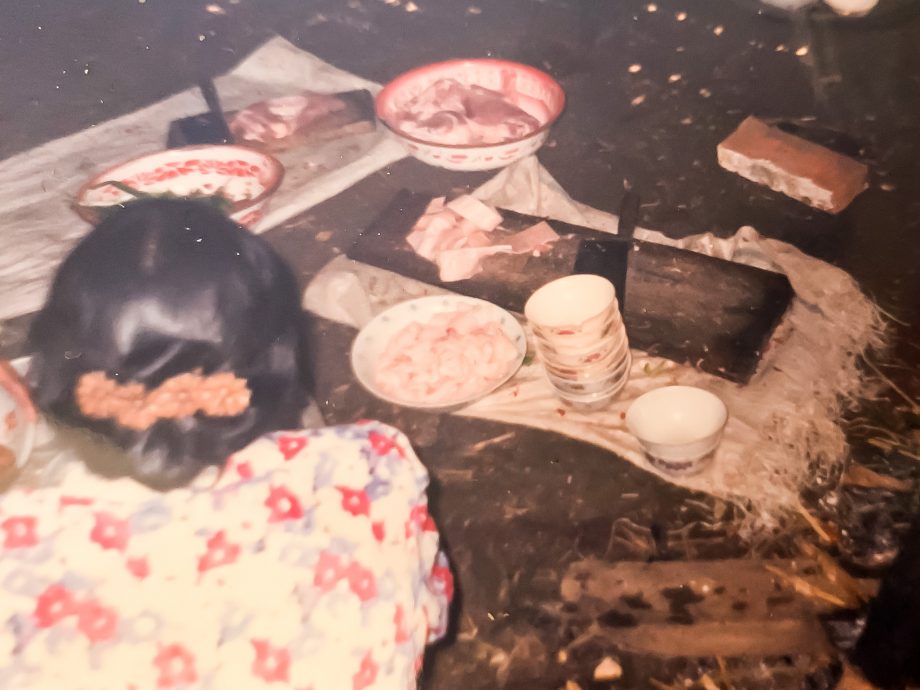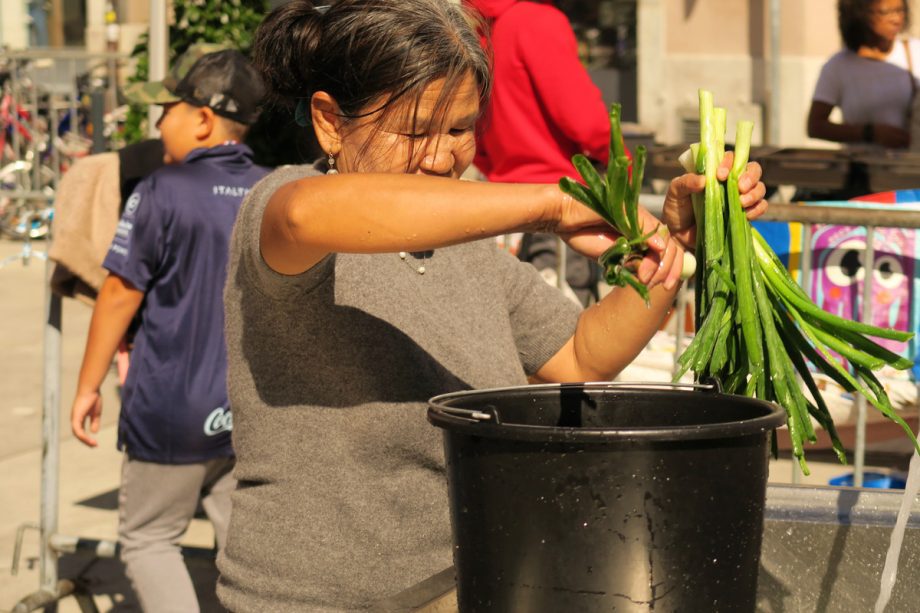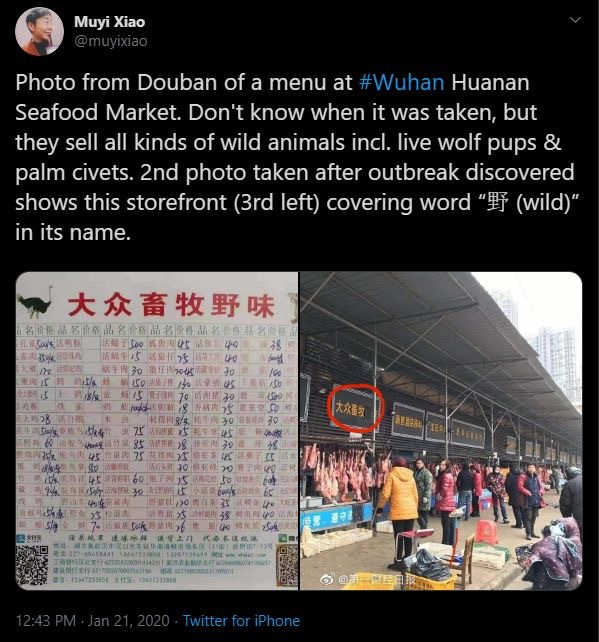The Cultural Construction of the ‘Bizzare’
Disentangling Sinophobic Language in Media and Science During the COVID-19 Epidemic
The Wuhan virus, the Chinese virus, or SARS-CoV-2? Wording matters!
I always treated the Chinese Virus very seriously, and have done a very good job from the beginning, including my very early decision to close the borders from China – against the wishes of almost all. Many lives were saved. The Fake News new narrative is disgraceful & false!
This tweet by president Donald J. Trump from 18 March 2020 is revealing in several dimensions. It displays not only the rift in US society between progressive and conservative forces or the corrosion of trust in scientific expertise but also an aversion towards China. When asked about this choice of words by CNN reporters, the president said he was not racist, but that new pathogens are always named after their origin and SARS-CoV-2 first appeared in Wuhan, China. Even if Wuhan may be the place of origin of the virus, which is not yet unequivocally proven, Donald J. Trump was biased in his naming practice, because the WHO had already issued a recommendation in 2015 to refrain from using place names when naming new viruses or diseases. On the one hand, because the place of first discovery need not necessarily be the place of origin. On the other hand, because naming places can be accompanied by social stigmatization. But from where does the President of the United States get this terminology? The first part of the answer might be obvious, from the media he consumes. The other part of the answer is far more complex and surprisingly, the scientific community might not be uninvolved in it either. In this contribution, I set out on a search for evidence for the talk of a Chinese virus by analyzing terminologies and metaphors used, when speaking about SARS-CoV-2.
Breakfast with CNN and Robert K. Merton
During breakfast in late January 2020, I saw a CNN news anchor displaying live on camera her disgust over a sea-food market in Wuhan (CNN 24 January 2020). Later that day I read a Guardian article (sponsored by the open philanthropy project) stating that the “appetite for warm meat drives risk of disease in Hong Kong and China” (Standaert 2020). And right before bedtime, I swiped through photo collections on businessinsider.com displaying with a sensationalist western-gaze what “Chinese wet markets look like” (Business Insider 2020). The next morning, I decided to get my information about this new coronavirus from more reliable sources. But even my trusted science communication portals like scientificamerican.com, www.nature.com and thelancet.com are not free from using a cultural biased or sometimes even insensitive images. Exemplary for this is Kate Jones’ (UCL Biodiversity) statement about Wet Markets as nuclear bombs in a Scientific American article about the creation of mass pandemics (Vidal 2020).
To be clear, I am not doubting that the handling and consumption of raw meat in markets like in Wuhan or Laos impose significant health risks both for individuals and the general population (see Walker et al. 2005; Hu et al. 2018) and that they need both governmental regulation and epidemiological monitoring. I am also convinced, that novel virus outbreaks like the recent one of SARS-CoV-2 deserve our full attention. But I am highly concerned about the language and images we are using to do so, since they are reproducing cultural prejudices and oftentimes contain moral judgments derived from a position of implied Western supremacy.
A more reflexive perspective towards science originated in the 1940s as a reaction to the atrocities of the Nazi scientists’ inhuman experiments on human beings. They showed that science is, and never was, pure (Shapin 2010) but argued also, that the neutrality of scientific knowledge should nevertheless serve as an institutional value for science. Robert K. Merton’s list of norms (communism, universalism, disinterestedness, and organized skepticism) is exemplary for this and influential until today (Merton 1942). Yet, we all, as members of the scientific community are not free of prejudice or cultural framings. Especially when we are dealing with something that is both new and has impacted our daily lives in a fundamental way like the current pandemic.
Against this backdrop it becomes understandable (but nevertheless problematic) when media and science forget to reflect about neutrality, when they are connecting novel virus outbreaks like HIV in the 1980s, SARS-CoV, MERS-CoV in the 2000s, or the recently discovered SARS-CoV-2 with the sexual, hygiene, or nutritional habits of the people in whose communities the virus was discovered the first time. That said, I believe it can be done better.
The cultural construction of the bizarre
SARS-CoV-2 is the third reported zoonotic human coronavirus in the 21st century. Its potential origin has been tracked down by Chinese officials and epidemiologists to the Huanan South China Seafood Market in Wuhan. Although an initial report suggested that the meat of snakes might be the source of the virus, the WHO has reported, after taking environmental samples, that no specific animal association has yet been identified (Gralinski & Menachery 2020), although some genetic markers point to similarities to the bat related corona virus of 2002, recombined with to date unknown DNA elements (Ji et al. 2020).
Even though the origin of this novel virus variant remains unclear, both traditional and social media have begun fearmongering campaigns by othering both Chinese culture and its nutritional practices, sometimes recreating the ghostly atmosphere of the “yellow peril” (Frayling 2014). In sociology and philosophy othering describes processes of constructing one’s own social belonging by classifying people with other characteristics and habits as different and ultimately foreign. Othering is therefore an emphasized distinction and distancing from the others, be it because of skin color, gender, religious beliefs, ethnicity, nationality, social position or subtler by norms, values, virtues, and cultural practices (see Jensen 2011). In current and former outbreaks of certain types of viruses in the so-called Global South, the description of certain cultural practices has become a tool for self-preservation by othering local populations and re-constructing a sense of cultural superiority for oneself. An early example for this is the panic surrounding the consumption of so-called bushmeat, especially Chimpanzees, which might have led to mutations in the simian foamy virus leading to the HIV-1 variant responsible for the beginning of the HIV epidemic of the 1980s and 1990s (Chitnis et al. 2004; Keele et al. 2006). While scientists were tracking the epidemiological and genetic origins of the virus, popular media re-evoked on its basis once more the “long and ugly tradition of treating Africa as a dirty, diseased place” (Seay & Dionne 2014).
Something similar is happening with the vocabulary and imagery surrounding the group of 21st century coronaviruses which have originated in Asia and the Middle East. This can be observed on social media, where discussions about SARS-CoV-2 infuses facts about the virus with problematic assumptions about China, a country which historically has been antagonized by Western societies (Zhang 2008) and due to its economic power is currently again subject to Anti-Chinese sentiments, especially in the United States (Silver et al. 2019). These sentiments are fueled (and re-affirmed) by framing Chinese nutritional traditions as “bizarre” and “disgusting” health hazards, that are underregulated and put the whole world at risk.

Image 1: Woman preparing meat after visiting a local market. 江北Jiangbei region. Source: Patricia A. Solomon 2001 – Pad&Lens Photographies Geneva. Reproduced with permission.
An example is the use of the term “wet market” and the ways in which such markets are described in the media, especially the Huanan South China Seafood Market in Wuhan. A literal translation of the term 街市 (jiē shì) just means “street market.” The differentiation between wet markets that are selling fresh meat, fish, and vegetables and dry markets that sell more durable goods, such as electronics, stems from English speakers in Hong Kong and Singapore and may have its roots in the colonization of these places by the British Empire in the 19th century (Sze-Ki 2008). It associates “wet” with both the blood of freshly slaughtered animals and “unsanitary” storage practices. It also signifies the linguistic boundary work of the Westernized middle and upper classes in Hong Kong and in Singapore of the 1950s and 1060s distancing themselves from the lower-class people who have to buy their goods at “traditional markets” rather than in the standardized assortments of supermarkets (Sze-Ki 2008). Here, the term “wet” signifies (from an incorporated Western perspective) distrust in the quality of nutritional products and prejudice towards foreign practices of hygiene – distancing oneself from “the other.” A behavior that finds its mirror image in discussions about banning ritual halal and kosher animal slaughter in European countries like Belgium, where arguments about food safety and animal rights have been interwoven (Havinga 2010). Unlike the markets of mainland China or the vendors of kosher and halal meat, similar markets both in Europe and North America are subjects to a different cultural framing. They are oftentimes associated with values like “locality,” “freshness,” and “quality,” although their assortments oftentimes also include “warm meat.” We have to ask, why such distinctions are made.
“Warm meat” and SARS-CoV-2
In the current Western media coverage about SARS-CoV-2 this form of othering becomes reproduced and recontextualized to fit our stereotypes about China. One example is Michael Standeart’s Guardian article “Appetite for warm meat drives risk of disease in Hong Kong and China” (Standeart 2020). The author is not only adapting the problematic term wet market, but also refers to the products sold at such places as “warm meat,” which is “freshly slaughtered rather than chilled.” Therefore, he is not only falsely generalizing (since only certain products at such markets are not chilled or are problematic if not chilled), but also implies that the practice of freshly slaughtered meat is a health hazard in itself. Although this is not wrong, since the handling of raw meat can always be a health danger, the statement is problematic, since also in Western cultures raw meat is sold and consumed under similar conditions. Given the examples of French fine cuisine (e.g. “bresse gauloise” or escargot), American ground beef, Bahamian conch, Japanese sushi, or fresh Labskaus from northern Germany, it seems unclear to me why the preferences of Chinese people (their “appetite for wild animals”) needs to be disproportionately emphasized.

Image 2: Woman washing spring onions at a traditional market: Is it in China or in Switzerland? Source: Dana Mahr 2019 – Pad&Lens Photographies Geneva.
It is the occurrence of a new virus variant at a specific market in Wuhan, not the cultural habits and preferences of the Chinese people that should be of public interest. Signifying the cultural habits of certain people as a health hazard could even lead to problems in our own social environments, since it might blind us to the dangers of similar habits in “our culture.” Equally problematic is the tendency of journalists to add long lists of the species which are sold at markets like the Huanan South China Seafood Market. The most extreme example for this has been published by Jonathan Yee at the social media aggregator portal MSNEWS (mustsharenews.com). Under the topic “Bizarre Wuhan Wet Market Menu Shows Over 100 Wild Animals Sold As Food,” the author cites 23 items found in a photograph of a menu that has been published on
Twitter on 21 January.

Image 3: Tweet by the CNN correspondent Muyi Xiao describing the menu at the Huanana market in Wuhan, where SARS-CoV-2 might have originated. Source: https://twitter.com/muyixiao, last accessed 16 April 2020. Reproduced with permission.
Although the author narrows down and admits that a “link (with the) virus (is unclear)” (Yee 2020), he exoticizes and moralizes Chinese nutritional habits, while describing in problematic and partly insulting terms the hygienic conditions at said market beyond justified concerns. This kind of cultural insensitivity and antagonization is implicitly communicating harmful ideas, such as “with these eating habits, the Chinese are endangering all of us” and “we might have to teach them how to adapt to a less harmful diet” (ibid). While the first statement might foster sinophobic resentment, the latter implies the dangerous thought of cultural superiority. These ideas might seem to be even more inappropriate, if we imagine people from other cultures analyzing the menu of a trendy cheese store in Greenwich Village or making moralizing assumptions about the Western diet and the obesity epidemic in the United States.
The infestation of science
While a certain type of alarmism and othering seems to be an integral part of media coverage in times of Twitter, Facebook, Fox News and co, the most unsettling trend connected to the moralizing sinophobia surrounding the recent outbreak of SARS-CoV-2 is that some aspects of the harmful imaginary and language also found its way into more reliable sources like popular science portals and even academic papers. Whereas, for example, scientificamerican.com adapted the problematic term “wet market” without reflecting about its origins, a Nature contribution by Ewen Callaway and David Cyranoski is (although the authors are disproving the snake-hypothesis that has been initially connected to the current outbreak) perpetuating the exoticism of Chinese eating habits by listing the various animals and animal parts which may or may not be sold at markets in China, without adding epistemic value with that list (Callaway & Cyranoski 2020).
Against the backdrop of both the growing political resentment towards China in the Western world and the rise of populism, with an alarming resurgence of a language of fear and otherness, the scientific community should consider questioning cultural biases when writing about SARS-CoV-2. Prejudices about cultural habits and the communication of undoubtedly important findings about the new coronavirus 2019 should not go hand in hand. A basic level of reflexivity and sensitivity could be reached, for example, by reflecting on the origins of certain words we are using, by asking if certain additional descriptions (like lists of sold animals) are necessary to communicate a specific finding or by exploring to what extent one’s own political and/or cultural thinking might affect the way in which we write our scientific papers or texts in general.
first submitted on 16.04. / revised version from 21.04.
Dana Mahr is senior researcher at the University of Geneva, Switzerland. Her research centers on how “common people” make sense out of science, technology, and medicine from a comparative and interdisciplinary perspective. As member of the Institute Confucius she is currently exploring how the implementation of personalized medicine impacts minority groups in China. She can be contact via E-Mail: dana.mahr@unige.ch
#WitnessingCorona
This article was simultaneously published on the Blog Medical Anthropology. Witnessing Corona is a joint blog series by the Blog Medical Anthropology / Medizinethnologie, Curare: Journal of Medical Anthropology, the Global South Studies Center Cologne, and boasblogs.
Bibliography
Billé, Franck. 2015. Sinophobia. Anxiety, violence and the making of Mongolian identity. Honolulu: University of Hawaii Press. Études mongoles et sibériennes, centrasiatiques et tibétaines, 2016. Published online 21 December. http://journals.openedition.org/emscat/2854. Last access 28/01/2020.
Chitnis, Amit, Diana Rawls & Jim Moore. 2000. Origin of HIV Type 1 in Colonial French Equatorial Africa? In: AIDS Research and Human Retroviruses 16, 5-8.
CNN. January 24 coronavirus news – CNN. 2020. https://edition.cnn.com/asia/live-news/coronavirus-outbreak- hnk-intl-01-24-20/index.html. Last access 28/01/2020.
Gralinski, Lisa E & Vineet D. Menachery. 2020. Return of the Coronavirus: 2019-nCoV. In: Viruses 12 (2), 135.
Hu, Yanan, Wenfeng Zhang, Gang Chen, Hefa Cheng & Tao Shu. 2018. Public Health Risk of Trace Metals in Fresh Chicken Meat Products on the Food Markets of a Major Production Region in Southern China. In: Environmental Pollution 234, 667-676.
Jensen, Sune Qvotrup. 2011. Othering, Identity Formation and Agency. In: Qualitative Studies 2 (2), 63-78.
Ji, Wei, Wei Wang, Xiaofang Zhao, Junjie Zai & Xingguang Li. 2020. Homologous recombination within the spike glycoprotein of the newly identified coronavirus may boost cross-species transmission from snake to human. In: Journal of Medical Virology, 92 (4). [DOI:10.1002/jmv.25682]
Keele, Brandon F, Fran van Heuverswyn, Yingying Li, et al. 2006. Chimpanzee Reservoirs of Pandemic and Nonpandemic HIV-1. In: Science 313, 523-526. [DOI: 10.1126/science.1126531]
Merton, Robert K. 1973 [1942]. The Normative Structure of Science. In: Merton R.K. The Sociology of Science: Theoretical and Empirical Investigations. Chicago: UCP, 267-278.
Shapin, Steven. 2010. Never Pure. 2nd ed. Baltimore: JHUP.
Silver, Laura, Kat Devlin & Christine Huang. 2019. U.S. Views of China Turn Sharply Negative Amid Trade Tensions. Pew Research Center’s Global Attitudes Project. Published online 13 August https://www.pewresearch.org/global/2019/08/13/u-s-views-of-china-turn-sharply-negative-amid-trade-tensions/. Last access 21/04/2020.
Standaert, Michael. 2020. Appetite for ‘warm meat’ drives risk of disease in Hong Kong and China. The Guardian. 2020; published online 23 January https://www.theguardian.com/environment/2020/jan/23/appetite-for-warm-meat- drives-risk-of-disease-in-hong-kong-and-china. Last access 28/01/2020.
Sze-ki, Lui. 2008. An Ethnographic Comparison of Wet Markets and Supermarkets in Hong Kong. In: The Hong Kong Anthropologist 2, 1-52.
Tan, Jason. 1997. Education and Colonial Transition in Singapore and Hong Kong: Comparisons and contrasts. In: Comparative Education 33 (2), 303-312.
Vidal, John. 2020. Destroyed Habitat Creates the Perfect Conditions. In: Scientific American Online. https://www.scientificamerican.com/article/destroyed-habitat-creates-the-perfect-conditions-for-coronavirus-to-emerge/. Last access 16/04/2020.
Walker, Polly, Pamela Rhubart-Berg, Shawn McKenzie, Kirstin Kelling & Robert S. Lawrence. 2005. Public health implications of meat production and consumption. In: Public Health Nutrition 8 (4), 348-356.
Woodward, Aylin. 2020. The outbreaks of both the Wuhan coronavirus and SARS likely started in Chinese wet markets. Photos show what the markets look like. Business Insider. 2020. https://www.businessinsider.com/wuhan- coronavirus-chinese-wet-market-photos-2020-1. Last access 28/1/2020.
Yee, Jonathan. 2020. Bizarre Wuhan Wet Market Menu Shows Over 100 Wild Animals Sold As Food, Link With Virus Unclear. MSNEWS. 2020. https://mustsharenews.com/wuhan-market-animals-menu/. Last access 28/01/2020.































